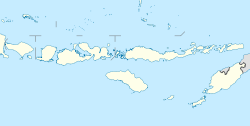Atambua
| Kota Atambua Atambua |
||
|---|---|---|
|
|
||
| Coordinates | 9 ° 2 ′ S , 124 ° 50 ′ E | |
| Basic data | ||
| Country | Indonesia | |
|
Geographical unit |
Nusa Tenggara | |
| province | Nusa Tenggara Timur | |
| ISO 3166-2 | ID-NT | |
| Residents | 26,396 (2010) | |
Atambua is a Desa and the capital of the Indonesian government district ( Kabupaten ) Belu . It is located in West Timor , which belongs to the East Nusa Tenggara Province , near the border with East Timor .
Surname
The name of the place is derived from the words "atan" ( German slave ) and "buan" ( German witch ) in the local language Tetum . Together it means something like "The slave of the demons". The demons are said to refer to the Portuguese and Dutch colonial rulers who ruled here early on.
geography
The city forms a district ( Kecamatan ) of the Belu administrative district. The district is divided into the Desas Fatubenao (7,664 inhabitants 2010), Atambua (3,591), Manumutin (9,994) and Tenukiik (5,147).
Residents
The Atambua district has 26,396 inhabitants (2010). The population mostly speaks Tetum as their mother tongue. Minorities use Kemak , Bunak or Uab Meto .
Atambua is the seat of the Atambua diocese , which is subordinate to the Kupang Archdiocese . Dominikus Saku has been the bishop since 2007 . The diocese, which also includes the administrative districts of North Central Timor and Malaka , has 493,044 inhabitants on 5,177 km². 96.5% of them are Catholics .
history
The Japanese took advantage during the occupation of Timor (1942-1945) Atambua to train pro-Japanese militia among the Timorese. The Japanese called them Heiho , the Portuguese Colunas negras . After the Japanese invasion, two groups of Timorese moved from Portuguese Timor to Atambua in the Netherlands. One from the kingdom of Deribate in today's Hatulia , another from Fohorem .
Between December 1974 and February 1975, an eight-man team from the Indonesian Kopassandha special unit , under the command of Colonel Dading Kalbuadi , began preparations in Atambua for Operation Flamboyan , with which the former colony of Portuguese Timor was infiltrated and the independence that was pending was prevented should be. 216 men of the East Timorese party APODETI , which advocated an affiliation of Portuguese Timor to Indonesia, were trained as partisans here. Its commander was Tomás Gonçalves . The Portuguese administration sent a delegation to Atambua in January 1975 to persuade the men to return to Portuguese Timor, but this was unsuccessful. At the end of April, the Kopassandha team was reinforced by 80 men.
After a failed coup attempt by the UDT against FRETILIN on August 11, 1975 in Portuguese Timor, Manuel Carrascalão , one of the UDT founders , fled to Atambua. Carrascalão later became one of the central supporters of East Timor's independence from the occupying power of Indonesia.
On September 6, 2000, three UNHCR employees were murdered in an East Timorese refugee camp in Atambua. The UN Security Council thereupon called on Indonesia with UN Resolution 1319 to take action against the militias that had their bases in West Timor, to disarm them and to secure the refugee camps and the border. The East Timorese Tomé Diogo is said to have carried out attacks on East Timor from Atambua in December 2002.
traffic
Atambua has an airport with the IATA code ABU. The nearby town of Atapupu serves as a port.
See also
Web links
Individual evidence
- ↑ a b c Kisho Tsuchiya: Indigenization of the Pacific War in Timor Island: A Multi-language Study of its Contexts and Impact , pp. 10-11, Journal War & Society, Vol. 38, No. February 1, 2018.
- ↑ a b Penduduk Indonesia menurut desa 2010 ( Memento from March 27, 2014 in the Internet Archive ) (Indonesian; PDF; 6.0 MB), accessed on January 26, 2013
- ↑ CAVR report from 2005: Part 3: The History of the Conflict ( PDF ; 1.4 MB)

